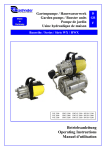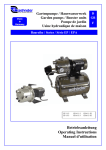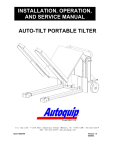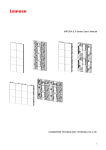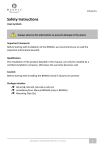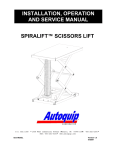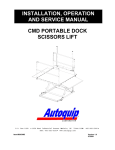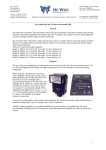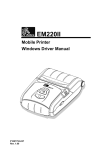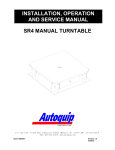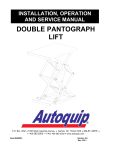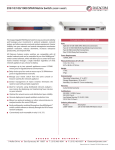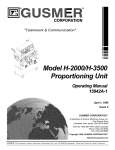Download PLATFORM RAM LIFT - Autoquip Corporation
Transcript
INSTALLATION, OPERATION AND SERVICE MANUAL PLATFORM RAM LIFT P.O. Box 1058 Item # 830RAM • 1058 West Industrial Avenue Guthrie, • OK 73044-1058 • FAX: 405-282-8105 • www.autoquip.com 405-282-5200 • Version 1.0 05/2002 TABLE OF CONTENTS Identification & Inspection 3 Dangers, Warnings, and Cautions 4 Label Identification 8 Specifications 11 Blocking Instructions 14 Installation Instructions 16 Operating Instructions 26 Routine Maintenance 28 General Maintenance 30 Replacement Parts List 34 Troubleshooting Analysis 35 IMPORTANT Please read and understand this manual prior to installation or operation of this equipment. Failure to do so could lead to property damage and/or serious personal injury. If any questions arise, call a local representative or Autoquip Corporation at 1888-811-9876 or 405-282-5200. PLANNED MAINTENANCE PROGRAM A local Autoquip representative provides a Planned Maintenance Program (PMP) for this equipment using factory-trained personnel. Call a local representative or Autoquip Corporation at 1-888-811-9876 or 405-282-5200 for more information. 2 IDENTIFICATION & INSPECTION IDENTIFICATION When ordering parts or requesting information or service on this lift, PLEASE REFER TO THE MODEL AND SERIAL NUMBER. This information is on a nameplate attached to the lift platform. Replacement parts are available from a local Autoquip distributor. INSPECTION Immediately upon receipt of the lift, a visual inspection should be made to determine that the lift has not been damaged in transit. Any damage found must be noted on the delivery receipt. In addition to this preliminary inspection, the lift should be carefully inspected for concealed damage. Any concealed damage found that was not noted on the delivery receipt should be reported in writing to the delivering carrier within 48 hours. The following is a checklist that will aid in the inspection of the lift. 1. Examine entire unit for any signs of mishandling. Pay special attention to the power unit and controls. 2. Thoroughly examine all connections, making sure they have not vibrated loose during transit. 3. Check to make sure tat there are no missing parts. If any parts appear to be missing, contact the Autoquip Customer Assurance Department immediately. 3 DANGERS, WARNINGS & CAUTIONS SAFETY ALERTS (Required Reading!) The following SAFETY ALERTS are intended to create awareness of owners, operators, and maintenance personnel of the potential safety hazards and the steps that must be taken to avoid accidents. These same alerts are inserted throughout this manual to identify specific hazards that may endanger uninformed personnel. Identification of every conceivable hazardous situation is impossible. Therefore, all personnel have the responsibility to diligently exercise safe practices whenever exposed to this equipment. ____________________________________________________________ DANGER! Identifies a hazardous situation that presents the imminent probability of death or of severe personal injury!! _____________________________________________________________ WARNING! Identifies a hazardous situation that has the potential of causing death or serious personal injury. ________________________________________________________________ CAUTION! Identifies a hazardous situation that could lead to the possibility of personal injury of death, and/or may result in equipment damage. _____________________________________________________________ 4 DANGERS, WARNINGS & CAUTIONS Read and understand this manual and all labels prior to operating or servicing the turntable. All labels are provided in accordance with ANSI Z535.4. DANGER! Do not work under lift without Maintenance Device! To avoid personal injury, NEVER go under the platform until the load is removed and the platform is securely blocked in the open position. See "Blocking Instructions" section. DANGER! To avoid personal injury, stand clear of platform while it is in motion. DANGER! Do not install the lift in a pit unless it has a bevel toe guard or other approved toe protection. A shear point can exist which can cause severe injury to the foot. DANGER! HIGH VOLTAGE!! Disconnect and/or lock out the electrical supply to the power unit prior to any maintenance being performed. 5 DANGERS, WARNINGS & CAUTIONS DANGER! Ram lifts are designed individually for a specific load and application. To avoid personal injury, do not change the load or application from the original design. WARNING! NEVER stand, sit or ride on the lift. WARNING! All warning and information decals should be in place as outlined in the “Label Identification” section. If decals are missing or damaged, they should be replaced with new ones. Contact Autoquip for replacements. WARNING! Lift platforms traveling below floor levels may create a hazard, and the shape of the load and how the load is arranged on the platform may create a toe hazard as the load passes the top edge of the pit. Both situations may require guarding in accordance with Federal Regulations. Any such guarding must be installed prior to operating the lift. WARNING! To avoid personal injury, NEVER go under the lift platform or perform any maintenance on the lift until the load is removed and the platform is securely blocked in the open position. See "Blocking Instructions" section. 6 . DANGERS, WARNINGS & CAUTIONS CAUTION! Do not continue to depress the “UP” button on the controller if the lift is not raising or if it has reached the fully raised position. To do so may result in permanent damage to the motor or pump. CAUTION! Never run the pump for more than a couple of seconds without pumping oil. This applies to low oil conditions, improper motor rotation, running the pump against the relief pressure after the lift is fully raised against the physical stops, running overloaded beyond capacity, or running at reduced speed because of pinched or obstructed hydraulic lines. CAUTION! Do not operate the power unit on relief for more than a few seconds. When on relief, the valve will make a squealing sound. CAUTION! Precautions should be taken to prevent the introduction of contaminates such as water, dirt or other foreign material into the system through open fittings, pipes or disassembled components. Contamination will ruin the hydraulic system. CAUTION! Use only approved oils in the lift. Maintenance section. 7 See “Oil Requirements” in the LABEL IDENTIFICATION 3 1 2 4 5 6 6 Figure 1 Label Placement Diagram Platform Ram Lift Item No. Qty Description Part No. 1 2 Caution – Familiarize Yourself With Operators Manual 36401487 2 2 Caution – Do Not Go Under Lift Platform . . . 36400679 3 2 Warning – Handrails and snap chains 36403715 4 1 Autoquip Serial Number Nameplate 36401511 5 2 Capacity 36401602 6 1 Safety Striping 06100010 8 LABEL IDENTIFICATION Note: Labels shown here are not actual size. Figure 2 Label 36401487 Figure 3 Label 36400679 Figure 4 Label 36403715 9 LABEL IDENTIFICATION Figure 5 Label 36401511 Figure 6 Label 36401602 Figure 7 Label 06100010 10 SPECIFICATIONS APE Selection Chart – Single Ram 20,000 lb Rollover Standard Model No. Platform Size (in) Lifting Cap (lbs) APE-0 48x48 APE-1 Axle Load Centered Over Ends Centered Over Sides 6,000 3,500 3,500 48x72 6,000 3,500 3,500 APE-2 72x72 6,000 3,500 3,500 APE-3 72x96 6,000 3,500 3,500 APE-4 72x120 6,000 3,500 3,500 APE-5 96x96 6,000 3,500 3,500 APE-6 96x120 6,000 3,500 3,500 Ram (qty) size Raising Time (fpm) Motor HP Approx. Shipping Weight (lbs) (1) 10Q (1) 10Q (1) 10Q (1) 10Q (1) 10Q (1) 10Q (1) 10Q 7 5 1,540 7 5 1,700 7 5 2,000 7 5 2,300 7 5 2,540 7 5 2,620 7 5 2,940 NOTE: Values shown are for single ram (APE) and double ram (DRAPE) models with 60” travel. Consult the factory for models that travel in excess of 60” or are in excess of the capacity shown. 11 SPECIFICATIONS Drape Selection Chart – Double Ram Drape 12 Drape 11 Drape 10 Drape 9 Drape 8 Drape 6 Drape 5 Drape 4 24,000 20,000 16,000 12,000 24,000 20.000 16,000 12,000 24,000 20,000 16,000 12,000 24,000 20.000 16,000 12,000 Centered Over Ends 11,000 24,000 16,000 16,000 12,000 24,000 13,000 15,000 10.000 24,000 14,000 16,000 11,000 24,000 20.000 16,000 12,000 Centered Over Sides (2) 12Q (2) 10Q (2) 12QSD (2) 12QEH (2) 12Q (2) 10Q (2) 12QSD (2) 12QEH (2) 12Q (2) 10Q (2) 12QSD (2) 12QEH (2) 12Q (2) 10Q (2) 12QSD (2) 12QEH (2) 12Q (2) 10Q 4 4 6 4 4 4 6 4 4 4 6 4 4 4 6 4 4 4 6 Std Motor 8 8 8 12 8 8 8 12 8 8 8 12 8 8 8 12 8 8 8 12 Opt Motor 10 10 7 1/2 7 1/2 10 10 7 1/2 7 1/2 10 10 7 1/2 5 7 1/2 10 7 1/2 5 7 1/2 10 7 1/2 5 7 1/2 Std 15 20 20 15 15 20 20 15 15 20 20 15 10 15 20 15 10 15 20 15 10 15 Opt 25,000 20,000 15,000 30,000 25,000 20,000 15,000 30,000 25,000 20,000 15,000 30,000 25,000 20,000 15,000 30,000 25,000 20,000 15,000 30,000 25,000 20,000 15,000 Lifting Capacity (lbs) 10,500 8,850 7,750 6,550 9,850 8,250 7,200 6,100 9,150 7,650 6,700 5,650 9,250 7,700 6,650 5,400 8,700 7,250 6,250 5,000 8,150 6,750 5,850 4,700 Approx. Shipping Weight (lbs) Motor (hp) Drape 13 12,000 16,000 (2) 12QEH 4 12 7 1/2 15 30,000 Raising Time (fpm) Drape 14 16,000 14,000 (2) 12QSD 6 8 7 1/2 20 Axle Load Drape 16 20.000 24,000 (2) 10Q 4 8 10 Rams Drape 17 24,000 10.000 (2) 12Q 4 8 Model # Drape 18 12,000 15,000 (2) 12QEH 4 Platform Size (in) Drape 20 16,000 13,000 (2) 12QSD Drape 23 Drape 19 Drape 15 Drape 7 Drape 3 Drape 2 Drape 1 Drape 21 20,000 24,000 96 x 180 84 x 180 72 x 180 96 x 144 84 x 144 72 x 144 Drape 22 24,000 Drape 24 12 SPECIFICATIONS LOADING The hydraulic ram type lift has the capacity rating stamped on a metal plate attached to the platform on one side of the lift. This figure is a net capacity rating for the lift as furnished when shipped from the Autoquip factory. The relief valve of the pumping unit has been set to raise the indicated amount of capacity plus a small amount of overload. Where gravity-roll sections, special tops, etc., are installed on the lift after leaving the plant, deduct the weight of these from the load rating to obtain the net capacity. The lift should never be overloaded beyond the established capacity, as serious damage to the ram assembly, the platform, and possible injury may result. UNBALANCED LOADING Unbalanced loadings of the lift is indicated on the nameplate showing the four sides of the lift and the maximum axle loads that the lift was designed to take over its sides. Axle load ranges stated as such take into account a 50% impact factor from rolling loads, and the equipment is stressed to take such loading on the standard platform as shipped from Autoquip. Any modifications of the standard platforms will result in deterioration of the axle load ratings across the edges of the platform and the factory should be consulted should any modifications in the field be considered. 13 BLOCKING INSTRUCTIONS DANGER! HIGH VOLTAGE!! Disconnect and/or lock out the electrical supply to the power unit prior to any maintenance being performed. APE 1. Unless specified otherwise, the non-rotator pipe (if installed) should be disconnected and the platform rotated 45º from it's home position. 2. The ram and platform are then lowered slowly by pressing the “DOWN” button until the platform rests safely on the floor above the pit opening. WARNING! To ensure a safe and stable descent, make sure all personnel and equipment are clear of the unit as it is lowered. 3. Continue holding the “DOWN” button for 10 – 15 seconds after the platform comes to rest on the floor to ensure that all hydraulic pressure in the system is removed. 4. Once the work is complete, raise the lift by pressing the “UP” button and lift the platform three to four feet above floor level. 5. Rotate the platform back into the home position and reconnect the non-rotator pipe. DRAPE 1. Unless otherwise specified, most dual-ram lift platforms rest on curbs or bumpers in a pit that is a minimum of 24” – 36” deep. Press the “DOWN” button to bring the platform to rest on these curbs, or other sturdy supports, onto all four corners of the platform. 14 BLOCKING INSTRUCTIONS 2. If more than 24” – 36” headroom is required, the lift platform can also be blocked open using one of the following approved procedures: A. Raise the lift past floor level and lay structural steel members diagonally across each of the four corners of the pit opening. These steel members must be of the same size and weight of the primary substructure members of the platform. Slowly bring the platform to rest on these steel members. B. Place jack stands under each of the four corners of the platform. The jack stands must be rated to stand the total weight of the platform plus the weight of the rams. To avoid damage to the deck, a large plate should be placed between the jack and the underside of the platform deck if the jack cannot be placed underneath a structural member. Slowly bring the platform to rest on the jack stands. WARNING! If the platform is left on jack stands and the rams(s) removed, care must be taken to prevent side impacts to the platform that could cause the stands to deflect or move and cause the platform to fall. 3. Continue holding the “DOWN” button for 10 – 15 seconds after the platform comes to rest on the floor or stands to ensure that all hydraulic pressure in the system is removed. 4. Once the work is complete, raise the lift by pressing the “UP” button. 15 INSTALLATION INSTRUCTIONS Read these instructions completely before starting the installation process. SITE INSPECTION The following site verification should be conducted prior to beginning ram installation. 1. Check the pit length and width dimensions to ensure that there is a minimum platform clearance of _” per side. 2. Check the pit diagonal distances to ensure that there is pit squareness and proper fit of the platform into the pit opening. 3. If the platform is to travel below the floor level, check all of the pit walls for plumbness and ensure that the platform will maintain a minimum _” clearance with the pit wall. 4. Consider all of the overhead obstructions (piping, utilities, building structure, cranes, etc.) that may interfere with the handling and setting of the ram. 5. Ensure that there is adequate depth and surrounding space to properly set the ram(s). POWER UNIT INSTALLATION 1. For best performance, power units should be installed within 25 feet of the ram lift and no higher in elevation than 12 feet above floor level. 2. Fill the reservoir with the recommended oil (see “Oil Requirements” in the Maintenance Section). 3. Mount the control panel and connect the primary power to the panel. 4. Mount the pushbutton station(s) and run the secondary power from the panel to the pushbutton, and from the pushbutton to the motor and down solenoid valve. DANGER! HIGH VOLTAGE!! Disconnect and/or lock out the electrical supply to the power unit prior to any maintenance being performed. 16 INSTALLATION INSTRUCTIONS RAM INSTALLATION – APE AND DRAPE 1. Do not lift the ram assembly by the plunger. A sling should be secured under the ram flange. The shipping wire on the end of the ram that was installed at the factory should be kept intact until it is time to operate the ram. This will prevent the plunger from turning and falling inside the casing. NOTE: The ram plunger surface must not be scratched during installation! 2. If the footing is not pre-set, suspend the ram in the hole at the proper height and block it into a plumb position. For single ram installation, be careful to properly orient the non-rotator pipe, when used. For dual ram installation, use the spreader channels to properly position the rams for cable equalization, when used. 3. Plumb in all planes by using a spirit level horizontally across the top edge of the plunger. Re-check with a level at right angles across the plunger. 4. Connect the elbow and riser pipes to the ram. For dual ram installation, connect the piping between the rams. Temporarily cap the top end. Use suitable pipe joint compound on all male threads. Make sure the riser comes to at least 12” above the finished elevation of the pit floor. 5. When the ram is reasonably level and centered, pour sufficient concrete to make the footing come up several inches above the bottom of the cylinder. Do not encase the entire cylinder length in concrete, or the ram casing removal will be impossible. Allow the concrete to set for 24 hours. 6. Begin backfilling with clean sand. Do not use cinders or other corrosive backfill anywhere near the cylinder or the piping. Fill the hollow ram-plunger with clean sand. This ballast is absolutely necessary for the rams to come down unloaded for proper lift performance and service convenience. Do not put any foreign material into air-over-hydraulic plungers; this will ruin the ram. NOTE: Prevent sand or dirt from getting around the seal-ring recess. 7. Tamp the backfill well and continue to recheck for proper centering, non-rotator position, and always recheck that the cylinder is plumb. Off-center positioning of 1/8” is acceptable, but 1/16” off level across the 10 _” diameter plunger will indicate that the cylinder is more than _” off plumb in its 90-inch length (for 60” travel). 17 INSTALLATION INSTRUCTIONS NOTE: Many times the footing will not set early enough to support the cylinder weight, so it must remain suspended. A poorly centered suspension or sling may try to pull the cylinder out of plum, even though it is fully backfilled. This is why the plumb of the cylinder should be re-checked often while backfilling, the suspension should be reasonably centered, and should be braced back to the pit walls or wedged with blocks at the top until the sling is removed. Do not use a sledge to drive the wedges as the cylinder may be damaged. 8. Install the reinforcement bar in the pit floor before the “top cap” of concrete is poured to finish the pit floor. If this rebar is not installed, the top cap may sink into the backfill beneath. PIPING INSTALLATION 1. Install piping between the ram inlet port (in the pit) and piping entering the pipe chase in the pit wall, and between the “stub up” out of the pipe chase to the power unit discharge port. Piping should be steel with a minimum wall thickness of schedule 40, and a diameter no smaller than the oil coupling connection on the ram(s). 2. To avoid introducing harmful debris into the piping, do not use Teflon tape; use pipe dope such as Loctite PST #567. Also, an air compressor should be used in the piping previously installed to blow out any possible debris in the pipe chase which my have been introduced during site construction. 3. Be sure to install at least one to two union fittings in the pit to allow for future maintenance by providing a means to drop the pipe manifold without removing the ram(s). A block valve installed near the riser in the pit will also prove useful for future maintenance by providing a means to block oil in the piping from the power unit. 4. It is best to leave enough space for a pipe wrench between the pit floor and the bottom of the pipe run. NOTE: For proper air-valve performance in APA (air-powered) models, the “IN” port must be connected to an air supply line and the “OUT” port to exhaust only. 18 INSTALLATION INSTRUCTIONS RAM START-UP PROCEDURE 1. Pre-fill all piping and ram(s) with oil. 2. Ensure that the factory shipping wire holding the ram plunger in position is removed before operating the ram(s). 3. Apply pressure to raise the ram about three feet. Loosen the bleeder screw in the flange two to three turns. Air trapped in the bearing space will escape. Leave the ram in this half-raised position until all of the bleeder air has escaped and clear, bubble-free oil runs from the bleeder. Allow plenty of time for this procedure. 4. Tighten the bleeder screw until snug. Don’t over tighten the screw as this can cause damage to the rubber seal washer. 5. Clean away all dirt, cement, sand, etc, from around the plunger and seal flange. Pour a little oil around the seal and raise the lift a few inches to carry up any remaining dirt particles. 6. Wipe the plunger clean, lower it to the ground, and refill oil to the proper level. 7. Raise the lift to its full height and apply full pressure to the system. 8. Lower the lift slightly below full rise and crack open the bleeder screw again to ensure that all air is out of the system. Re-tighten the bleeder screw. 9. While full pressure is on the system, check all piping thoroughly for leaks. 10. If it is leak free, complete the backfilling and pour the concrete “top cap” in the pit floor. Keep dirt and concrete away from the plunger and packing flange, as well as the cable equalizer struts, when applicable. Wipe the plunger with an oil soaked cloth to prevent rusting. 11. Let the concrete set for at least 24 hours, then recheck the plunger and seal-flange for cleanliness. SUMMARY – RAM INSTALLATION & START-UP 1. Set the rams in the pit. Be absolutely sure the rams are on pit centerline. 2. Brace against the pit walls. 3. Connect the oil lines between the power unit and the rams. 19 INSTALLATION INSTRUCTIONS 4. Run the rams up to full height. Test for leaks. 5. Plumb the rams by leveling them from the side of the plunger on all four planes. As a backup measure only, the rams may be plumbed from the top using a precision straight edge. However, this alone does not ensure a proper plumb. 6. If the rams are absolutely plumb and parallel, backfill and lower the rams. Cement around the openings. 7. Let the concrete set for 24 hours or more. PLATFORM INSTALLATION – APE 1. Lower the ram all the way and loosely bolt the ram to the bolster plate underneath the platform in the correct orientation using the hardware provided. 2. Raise the lift, and then pull up the non-rotator pipe and bolt it loosely to the superstructure underneath the lift platform. 3. Lower the lift all the way to check for clearance with the pit walls, and then position and tighten the bolts to the superstructure. 4. Tighten the non-rotator pipe. 5. The lift is ready to operate and should raise and lower freely if the non-rotator pipe is correctly adjusted and not binding at the bottom of the stroke. PLATFORM INSTALLATION – STRUCTURALLY EQUALIZED DRAPE 1. The rams must have all the air bled out to ensure that they will remain synchronized after the platform is attached. 2. Lower the rams all the way, then position and bolt the bolster plated located underneath the platform in correct orientation using the hardware provided. If visibility is too poor, raise the lift out of the pit to get enough light to see the bolt holes. Also, a tapping tool may have to be used to clear the threads in the end of the plunger of all sand and concrete that may have accumulated. 3. The lift is ready to operate and should raise and lower freely without binding the rams at any point of the lift travel. Binding will cause the lift to bounce or jerk during operation 4. Tighten all bolts. 20 INSTALLATION INSTRUCTIONS PLATFORM INSTALLATION – CABLE EQUALIZED DRAPE 1. The rams must have had all the air bled out to ensure that they will remain synchronized after the platform is attached. 2. Lower the rams all the way, then position and bolt the bolster plated located underneath the platform in correct orientation using the hardware provided. If visibility is too poor, raise the lift out of the pit to get enough sight to see the bolt holes. Also, a tapping tool may have to be used to clear the threads in the end of the plunger of all sand and concrete that may have accumulated. 3. Unwind the cable from each of the strut assemblies and lay it out on the pit floor. One end will have been attached at the factory. 4. Raise the struts and bolt them both to the bottom of the bolster plate with the hardware provided. 5. Before the cables are tightened, raise the rams to full travel. 6. Make sure that both eye-bolts on the bolster plate are backed out as far as possible, then begin taking out all slack in each cable and tighten as much as possible. Use a “come-along” or other mechanical device to tie off to the opposite ram and tighten until it is impossible to tighten it further. 7. As the cable is tightened, the spare cable length will grow longer on the free end. Do not cut off any spare cable until the tightening is completely finished and the lift is commissioned for use. 8. While tightening and taking up cable around the end thimble, the thimble will try to rotate with the cable being pulled past it. Use a hammer or other tool to keep the thimble in the correct position. 9. Once all of the tightening at the free end is complete, cut off the excess cable. 10. Go back to the eye-bolts on the bolster and attempt to tighten the cable further by screwing the eye-bolts in. 11. When work with the cable is complete, the cable can be stood upon with no visible deflection. 12. Run the lift through full travel several times to ensure that the platform is level in the fully raised position. 21 INSTALLATION INSTRUCTIONS HAS TO BE LEVEL BOTH WAYS PRECISION-STRAIGH -D T E G LEVEL NO CLEARANCE UN ER D (4) POI S T N MUST BE SAME DIMENSION TOP AND BOTTOM ± 1/64" Figure 8 Leveling Rams 22 INSTALLATION INSTRUCTIONS 18 " TYP. 18 " TYP. CONCRETE BUMPERS ( 4 ) CORNERS ( BY PIT CONTRACTOR) WASHER PLATE & RAM BOLTS 12" PLATFORM WIDTH "A" "A" RAM LOCATED IN CENTER OF PLATFORM PIT WIDTH (PLATFORM WIDTH + 2" ) 36" ROUND OR SQUARE OPENING IN PIT FLOOR FOR SETTING RAM. HANDRAILS AND SNAP CHAINS NOT SHOWN FOR CLARITY. 1 " TYP. PLATFORM LENGTH 1 " TYP. PIT LENGTH (PLATFORM LENGTH + 2" ) REMOTE POWER UNIT: LOCATE WHERE CONVENIENT. NON-ROTATOR ASS,Y. LIFT TRAVEL BEVEL TOE GUARDS ON ( 4) SIDES WITH YELLOW AND BLACK STRIPED TAPE. ELBOW RAM SETTING DIM. FROM FLOOR LEVEL TO TOP OF RAM FLANGE. CURB ANGLES (BY OTHERS) 1 3" UNION PIPE CHASE (BY OTHERS) 36" APPROX. PIT DEPTH RAM LENGTH OIL LINE TO RUN BEFORE CONCRETE IS POURED. UNION CONCRETE BUMPERS TYP. ( 4) CORNERS ( BY OTHERS) 9 " ROUND OR SQUARE OPENING FOR SETTING NON-ROTATOR (BY OTHERS). REINFORCING BAR WELDED TO CASING (BY PIT CONTRACTOR) CLEAN SAND BACKFILL (BY INSTALLER) 36 " DIA. X 1 /4" WALL STEEL CASING, IF REQUIRED ( BY PIT CONTRACTOR) FOOTING SECTION "A-A" Figure 9 General Arrangement - APE 23 INSTALLATION INSTRUCTIONS " PIT LENGTH (PLATFORM LENGTH + 2" ) "PIT WIDTH 18" TYP. "A" (PLATFORM WIDTH + 2") 18" TYP. "A" RAM C.L. HANDRAILS AND SNAP CHAINS NOT SHOWN FOR CLARITY. CURB ANGLES ( BY PIT CONTRACTOR) CONCRETE BUMPERS ( 4) CORNERS (BY PIT CONTRACTOR) 1" TYP. REMOTE POWER UNIT LOCATE WHERE CONVENIENT 1 " TYP. LIFT TRAVEL BEVEL TOE GUARDS ON ( 4) SIDES WITH YELLOW AND BLACK STRIPED TAPE. ELBOW RAM SETTING DIM TO TOP OF RAM FLANGE RAM WASHER PLATE UNION OIL LINE TO RUN BEFORE CONCRETE IS POURED 3 6" APPROX. PIT DEPTH CONNECTING PIPE (BY PIT CONTRACTOR) RAM TIE ROD REINFORCING BAR WELDED TO CASING (BY PIT CONTRACTOR) FOOTING CLEAN SAND BACKFILL (BY INSTALLER) RAM LENGTH PIPE CHASES (BY PIT CONTRACTOR) 4 2" X 42" X 1 / 4" WALL STEEL CASINGS (BY PIT CONTRACTOR) FOOTING SECTION " A-A" Figure 10 General Arrangement – DRAPE 24 UNION (TYP) 25 Figure 11 Cable Threading Diagram OPEN SOCKET FOR CABLE B CABLE B CABLE B STRUT TUBE EQUALIZER STRUT PIT CHANNEL SHEAVES CABLE A CABLE A CABLE B EYE BOLT THIMBLE CABLE CLIPS TO CL RAMCL OPEN SOCKET FOR CABLE A CABLE A CABLE A THIMBLE CABLE B EXTRA HEAVY RAM DUAL OIL LINE COUPLING INSTALLATION INSTRUCTIONS OPERATING INSTRUCTIONS Familiarize yourself with this operator’s manual before operating the equipment!!! The remote self-contained power unit consists of an electric motor directly coupled to a pump with a suction filter, check valve, relief valve, and solenoid down valve mounted to a reservoir. 1. Ram lifts have maximum lifting capacity ratings (see “Specifications” section). The safety relief valve has been factory set to open at a pressure slightly above the rated load capacity and allows the oil to bypass into the reservoir to prevent damage to the lift and its hydraulic power unit. The safety relief valve should not be adjusted for any reason as it could cause the motor to prematurely burn out. Applying loads exceeding the rated capacity of the lift may result in excessive wear and damage to the lift. 2. This type of lift is typically furnished with constant pressure pushbutton controls. Actuating the "UP" button will cause oil to enter the ram(s) and the lift will rise. 3. When the desired height or upward travel of the platform is attained, removing pressure from the button deactivates the “UP” circuit. The oil stops flowing and the upward movement will stop. 4. Activate the "DOWN" button to lower the lift. Opening the down control valve allows the oil in the ram(s) to flow through the down valve at a controlled rate and return oil to the reservoir. 5. When the desired height or downward travel of the platform is attained, removing the operator’s hand from the button deactivates the “DOWN” circuit. The oil stops flowing from the ram(s) and the downward movement will stop. CAUTION! Do not continue to activate the "UP" button if the lift is not raising or if it has reached the fully raised position. To do so may result in permanent damage to the lift. 26 OPERATING INSTRUCTIONS CAUTION! Do not operate the power unit on relief for more than a few seconds. When on relief, the valve will make an audible squealing sound. All automatic controls added to the lift must include provisions for immediately shutting off the pumping unit at the top travel of the lift, and releasing the solenoid at the bottom travel of the lift. CAUTION! Care should be taken when loading the platform lift to insure that the “Rated Axle Load Capacity” and the “Lifting Capacity” is not exceeded. Overloading can cause damage or failure to the equipment and can result in personal injury. 27 ROUTINE MAINTENANCE Normally platform ram lifts require very little maintenance. However, a routine maintenance program could prevent costly replacement of parts and/or downtime. WARNING! To avoid personal injury, NEVER go under the lift platform or perform any maintenance on the lift until the load is removed and the platform is securely blocked in the open position. See "Blocking Instructions" section. MONTHLY INSPECTION: 1. Check oil level (see “Oil Requirements” in this section) and add appropriate oil when necessary. a. Rams already in service need prefilling to the proper checkpoint before bleeding, only when they are suspected of having less than two-thirds of their normal oil supply. b. To bleed the trapped air from rams already in service: Raise the empty lift half way and loosen the bleeder plug four turns. When the oil comes out air-free, tighten the bleeder plug. c. All rams should be lowered fully to check the oil. However, when there is no superstructure on the ram, it should not be lowered below the cylinder flange, except for seal-ring replacement and/or cleaning the seal-ring groove. d. Remove the fill plug of the reservoir and fill it to within two inches from the top. e. Replace the fill plug. 2. Check for any visible leaks. Correct as necessary. 3. Check any unusual noise when it occurs. Determine the source and correct as necessary. 4. Check all wiring for looseness or wear. Repair at once. 5. Keep all bolts tight. 6. Keep the superstructure and surrounding area free of oil, grease, and dirt. 28 ROUTINE MAINTENANCE 7. Use caution in determining the need for repacking. Know the difference between controlled “weepage” which is necessary for lubricating the packing and “leakage” beyond toleration. A dry-wiping packing is not necessary. The perfect packing leaves an oil film that can be felt but not seen on the piston. OIL REQUIREMENTS: Change oil if it darkens materially or feels gummy or gritty. Do not use hydraulic-jack oil, hydraulic fluids, brake fluids, or automatic transmission fluid. Use only oils that are 100 to 150 SSU at 100º F. Call the Autoquip Customer Assurance Department for recommended brands, if necessary. OIL CAPACITY: Reservoir capacity (gallons) for the steel tank can be approximated by the following formula: Tank Width X Length X Height (in inches) 231 (cubic inches per gallon) PIPE THREAD SEALANT Loctite PST #567 pipe thread sealant or equivalent is recommended. Do not use Teflon tape. Tape fragments can cause malfunctioning of the hydraulic system. 29 GENERAL MAINTENANCE CAUTION! Never run the pump for more than a couple of seconds without pumping oil. This applies to low oil conditions, improper motor rotation, running the pump against the relief pressure after the lift is fully raised against the physical stops, running overloaded beyond capacity, or running at reduced speed because of pinched or obstructed hydraulic lines. PUMPS Pumps cannot be field repaired, nor should they be taken apart. Wear or any internal damage occurs to the gears and to the pump body, making pump repair impractical. Complete replacement is necessary when the pump becomes defective. GOULD SOLENOID VALVES Piston pilot operated Gould solenoid valves should last for years in general applications. The coil assemblies are replaceable by removing one screw. Should the lift “creep” down, the valve seat can be cleaned by removing the bonnet nut without taking the valve from the pipeline. Take care not to damage or force the plunger stem over which the coil is assembled. The lift must be fully lowered to relieve all pressure before dismantling. When removing the bonnet, the valve should be restrained by using a wrench on the hex flats at the pipe ports, not on the body. Oil that is too heavy for existing temperature will cause a sluggish valve action or refusal to open when under full-load pressure. These valves need a minimum pressure drop of 5 psi across the valve to operate. . 30 GENERAL MAINTENANCE Figure 12 Gould Solenoid Valve 31 GENERAL MAINTENANCE REPLACING RAM SEALS 1. Block the superstructure (see “Blocking Instructions”) and unbolt the platform bolster plate from the ram(s). It is recommended to mark the plunger and bolster with a chalk mark or paint to be able to orientate the plunger when re-attaching. NOTE: Do not allow the plunger to rotate 120 degrees during disassembly or it will drop below the surface of the seal flange. 2. Raise the ram several inches and clean thoroughly around the plunger and sealflange to prevent the possibility of any dirt particles from entering the seal space while servicing. If the top edge of the ram is rust-marked, it must be polished smooth or it will not pass through the seal. 3. Apply a light coat of grease around the ram. Lower until it bottoms about a half inch below the seal groove. If the lowering ram hits solid at about 3/8” above the sealflange, rotate it until the arrow stamped in the head plate points toward the bleeder screw, then finish lowering. The seal should now be exposed. 4. Remove the old seal. compressed air. Inspect and clean the seal groove using a rag and 5. If foreign matter drops down around the ram, remove as much as possible with an oil-soaked cloth and/or compressed air. Remove the seal ring and apply pressure to the system to raise the ram about six inches so that residual dirt particles will cling to its sides where it can be wiped off. Ignore a slight loss of oil around the ram while it is raised. When the ram is clean, lower it again, 6. Install the new Wiper-seal in the seal groove by pinching the seal as shown in Figure 15a. Work it all the way around with an inside loop in the seal as shown in Figure 15b. 7. Press the ring tightly into the groove with finger pressure. The ring must be straight and well seated in the groove before raising the piston. Apply a coating of grease to the new seal. 8. Using a slow jogging action, inch the ram up past the seal, being sure not to pinch it as it may squeeze out of the groove. Do not raise the ram all the way up without reinstalling the superstructure. The friction of the new seal may prevent it from lowering when empty. 32 GENERAL MAINTENANCE Figure 13a Figure 13b 33 REPLACEMENT PARTS LIST Specific part numbers vary from job to job, depending on the model and options chosen for the application. Call the Autoquip Customer Assurance Department with the serial number of the specific equipment to order the appropriate parts. SUCTION LINE W/ FILTER(S) OIL RESERVOIR FILLER BREATHER COUPLINGS AND SPIDER MOTOR RELIEF VALVE PUMP CHECK VALVE RETURN LINE DRAIN SOLENOID VALVE PRESSURE LINE TO RAM(S) Figure 14 Typical Power Unit 34 TROUBLESHOOTING ANALYSIS DANGER! To avoid personal injury, NEVER go under the lift platform until the load is removed and the platform is securely blocked. See "Blocking Instructions" section. PROBLEM POSSIBLE CAUSE AND SOLUTION Lift does not raise. • The motor voltage/wiring may be incorrect. • The hydraulic line or hose may be leaking. • Oil in the reservoir may be low. Add oil as necessary (See the “Routine Maintenance” section.) • The load may exceed the rating. (See the “Specifications” section.) • The suction screen may be clogged. Remove and clean the screen. Drain and replace the oil. • The suction line may be leaking air due to a loose fitting. Tighten as needed. • The breather holes in the reservoir fill cap may be clogged. Remove and clean. • The "Down" valve may be energized by faulty wiring or stuck open. Remove the solenoid and check. • The power unit pump may be defective • The structural members of the lift may be in a bind. Lift seems bouncy during operation. • There may be air in the hydraulic system. Bleed the air from the cylinder • Oil in the reservoir may be low. Add oil as necessary (See the “Routine Maintenance” section.) • The power unit suction strainer may be clogged. • The power unit suction line may be leaking. 35 TROUBLESHOOTING ANALYSIS PROBLEM Lift will not lower. POSSIBLE CAUSE AND SOLUTION • The down solenoid may be malfunctioning. • The structural members may be in a bind. • The piping is obstructed or broken. • The return filter may be clogged. • Should the above steps not correct the problem, contact Autoquip to obtain instruction for further action. Lift raises slowly. • The structural members of the lift may be binding. • The piping is obstructed or broken. Where pipe is used, check for obstruction in the line. • The hydraulic line or hose may be leaking. • The oil viscosity is not suited for the environmental conditions. Refer to “Routine Maintenance” section for oil requirements. • Check the oil level in the reservoir. • The motor voltage/wiring may be incorrect. • The suction screen may be clogged. Remove and clean the screen. Drain and replace the oil. • The suction line may be leaking air due to a loose fitting. Tighten as needed. • The breather holes in the reservoir fill cap may be clogged. Remove and clean. • The power unit pump may be defective. Lift lowers slowly. • The structural members of the lift are binding. • The tubing or hose is obstructed or broken. Where pipe is used, check for obstruction in the line. • The oil viscosity is not suited for the environmental conditions. Refer to “Routine Maintenance” section for oil requirements. 36 TROUBLESHOOTING ANALYSIS PROBLEM Lift will not remain in raised position. POSSIBLE CAUSE AND SOLUTION • The ram packing may be leaking. • The Gould valve or swing check valve is not seating. • The piping is leaking oil. 37





































